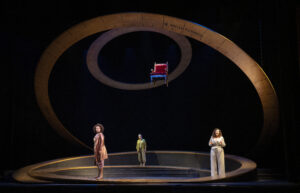La Clemenza di Tito is composed by Mozart and written by Caterino Mazzolà. This opera was originally performed in Prague in 1791; currently, it’s being shown at Victoria’s Royal Theatre through Pacific Opera Victoria. The score was performed wonderfully by the Victoria Symphony, and conducted by the talented Giuseppe Pietraroia.
The story revolves around Roman Emperor Tito. In the year 79 AD, Tito (Andrew Haji), a well-loved and benevolent emperor, wishes to take a bride, and just so happens not to choose Vitellia (Tracy Cantin), daughter of the prior emperor, who believes she is the rightful heir to the Queen’s throne. Scorned and livid, Vitellia urges Tito’s confidant Sesto (Taylor Raven), who is in love with her, to murder the emperor. After a convoluted and wearisome series of betrayals, miscommunication, and missteps, everything pretty much goes right back to normal, like a silly ol’ family sitcom.

As far as storylines go, it’s bloated and overwrought, with characters expending hundreds of words to express simple concepts, ad nauseam. Mostly static and unchanging, they undergo moral conundrums that resolve with little to no sense of satisfaction or personal growth. For example, Sesto remains easily manipulated and loyal to the wrong person, and Tito retains his over-idealized benevolence, despite having every justified reason to make the difficult choice, lest he be considered a pushover. Even though Sesto was his close friend, he still skewered an innocent man, incited a riot, and attempted a royal assassination. But it’s all cool, because Tito is a super nice guy and everybody knows it. I can’t imagine that wouldn’t set a dangerous precedent.
This benevolence trait is oversimplified to Christ-like proportions, which doesn’t make for an interesting or dynamic character arc. Despite the source material, Haji does a superlative job in the role, and I could say the same about most of the other actors, with Julia Dawson (as Servilla) also giving an astounding vocal performance despite how small the role is.
Regarding the songs, I was disappointed at the lack of variety among the voices. Two of the four women were voicing male characters, and I initially thought this was the cause of the lack of tonal variation until I checked the script and discovered they were all intended to be sopranos. This is bewildering, because there are several sequences where up to four women with nearly identical voices are all singing together, and considering half of those are male roles, I think there was a definite missed opportunity to create some tonal balance by interleaving high mezzo-sopranos with low basses or baritones. I experienced a feeling of opera fatigue, spending nearly three hours listening to mostly ear-splitting sopranos.
The experience for me was also marred by a baffling inconsistency in the surtitles. Throughout the production there were vast swaths of dialogue that were omitted, leaving the audience to merely guess what was happening. This felt akin to watching a television program where the audio cuts out frequently. I was told that sometimes repeated dialogue is not shown, which didn’t really fit, because most of the missed dialogue was not repeated, and much of the dialogue that was covered by the surtitles was repeated several times.
The other point of contention I had was the lack of creativity in the set and costume design, both headed by Camellia Koo. Despite appearing as a briefly interesting series of concentric rings, the set quickly revealed itself to be nothing more than a bare stage with static lighting, with almost no props other than a throne suspended far above the stage. The costumes, with the exception of Tito’s royal garb, were drab and lacked any sort of connection to the time period, or any exquisite detail whatsoever.
The last opera I watched in the Royal Theatre was Ainadamar, which boasted a dazzling set using multiple layers, front and rear projection, dynamic lighting, and detailed, expressive costumes. Compared to that, this opera was a lacklustre reminder of the tragedy of missed potential, and for a production of this size, I have no idea why it was so minimalistic as to be eclipsed many times over by even small community theatre projects.
Despite having a talented cast, La Clemenza di Tito was a disappointing opera whose writing, execution, and production quality all dipped far below what I expected from the eminent Pacific Opera Victoria, and I hope for better in the future.
